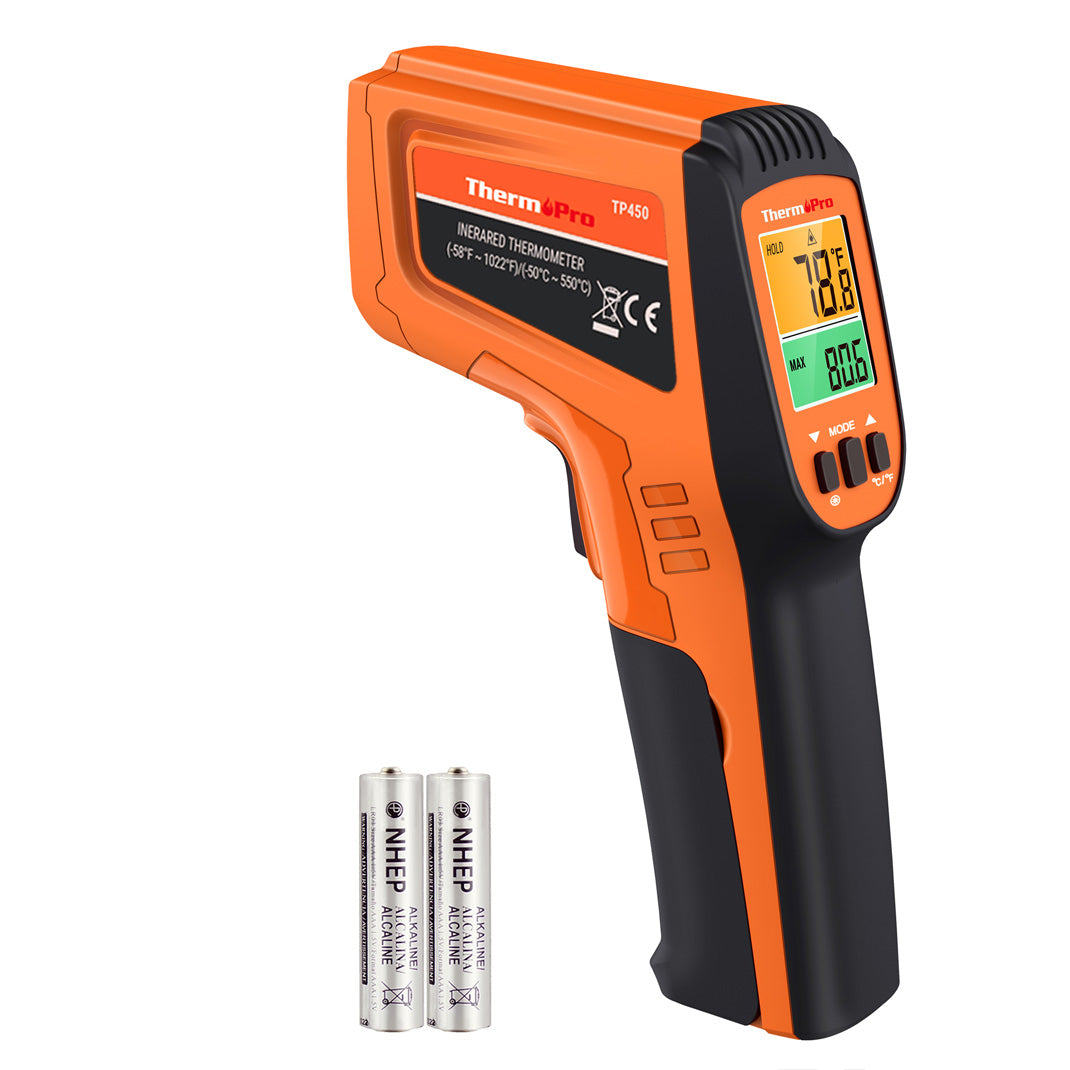How to Calibrate Infrared Thermometers






 288 Comments
288 Comments
Infrared thermometers have become indispensable in operations related to food safety, HVAC systems, automotive diagnostics, and even medical fields. These products have become popular in the home electronics market due to their non-contact capabilities. All the same, these devices require correct calibration to produce accurate readings.
In this article, we’ll show you how to calibrate infrared thermometers, which are also known as IR thermometers or laser thermometers.
How Do Infrared Thermometers Work?
Infrared thermometers detect the infrared radiation coming from an object and then convert it into a temperature reading. Objects radiate infrared radiation proportionally to their temperature. This is what the IR thermometer measures to give a temperature value.
The working procedure:
- Infrared Detection: The surface of the object emits radiation, which is detected by the sensor on the thermometer;
- Conversion: A detector in the infrared thermometer converts radiation into an electric signal;
- Temperature Calculation: The processor in the thermometer converts the electric signal into a reading according to the amount of energy detected.

Importance of Infrared Thermometer Calibration
Calibration is vital because the results produced by the infrared thermometer need to be highly accurate and reliable. However, the thermometer can show wrong temperature readings due to dust and debris on the lens, changes in atmospheric conditions, or the wearing out of internal parts.
Reasons for performing calibration
- Accuracy Assurance: Well-calibrated infrared thermometers give accurate readings, thus reducing any chances of error.
- Compliance with Standards: Industries related to food safety, healthcare, and manufacturing have quality and safety standards that need to be met and hence require periodic calibrations.
- Downtime Prevention: Routine calibration helps detect and identify potential risks that could alter the performance of the thermometer.
How to Calibrate Infrared Thermometers
There are several ways to calibrate infrared thermometers. These methods may vary depending on the type of tool used and the amount of accuracy being sought. The following are the most common methods used in the calibration of thermometers:
Ice Water Method
This method uses ice water as a reference for checking whether your infrared thermometer properly returns readings at 32° F (0° C).
- Fill a container with ice;
- Add water until all the ice is covered;
- Leave it to settle for some time;
- Stir up the mixture to ensure a uniform temperature has been reached;
- Make sure your infrared thermometer is set to an emissivity setting of 0.98;
- Aim the infrared thermometer at the surface of the ice water apparatus without letting the thermometer touch the water;
- Take a reading.
If properly performed, the reading should be 32°F (0°C). If not, the calibration of the thermometer needs to be corrected.

Boiling Water Method
Similar to the ice water technique, this method uses the boiling point of water as a reference at 212°F (100°C).
- Heat some water in a container until it hits its full boiling point.
- Aim the infrared thermometer at the surface of the boiling water while avoiding steam interfacing the head from the thermometer.
- The thermometer should read 212°F or 100°C; otherwise, calibration should be done.
These procedures are based on a few assumptions. The assumptions are normal atmospheric pressure and sea level due to changes in boiling points that are a result of changes in altitude.
Blackbody Calibration
A more accurate calibration could be performed with the use of a blackbody calibrator. Using a blackbody calibrator is a standard practice in laboratories, manufacturing, and research settings to ensure the accuracy and reliability of infrared thermometers. It emits infrared radiation at known temperatures, thus offering an established reference on which to base the calibration.
- Set the blackbody calibrator to an established temperature setting, such as 50°C and 100°C.
- Aim the infrared thermometer at the calibrator and take a reading.
- Refer back to the temperature you set on the calibrator. Compare this temperature with the reading of the thermometer. Adjust the settings on the infrared thermometer accordingly to provide the correct reading.
This technique is very accurate; thus, it finds its application in highly sensitive industries that require critical control of temperatures, such as laboratories and manufacturing.
Surface Probe Method
Another technique is utilizing a calibrated surface probe and taking the reading parallel to the infrared thermometer.
- Heat or cool a surface to a known, constant temperature.
- Point at the same surface where the exact temperature of that surface is measured by a surface probe, and simultaneously compare its reading with the infrared thermometer.
- In case there is a different reading, make adjustments to the infrared thermometer.
Troubleshooting Common Calibration Problems
There are other causes of calibration issues. Some general issues and troubleshooting methods include the following:
Variable Readings: The reading is changing while you try to calibrate it. To fix this, clean the lenses of your thermometer of fingerprints and dust. Filthy lenses will give false readings. Additionally, variable readings could be brought on by temperature changes in the surroundings brought about by drafts, heat sources, or cold air. Calibration is best carried out in a controlled environment.
Incorrect Distance: During the time of calibration, you should not be too close or too far away from the object, as this prevents the thermometer from picking the correct infrared radiation. Check guidelines concerning the distance-to-spot ratio as issued by the manufacturer.
How can you ensure that your infrared thermometer is always right? The following are some things to do to keep your infrared thermometer accurate.
- Cleaning: Remove dust and fingerprints that may block the path of the sensor by wiping with a soft dry cloth regularly.
- Controlled Environments: Keep your thermometer away from extreme temperatures, humidity, and shock, as they may impact the thermometer’s accuracy over time.
- Recalibration Schedule: The thermometer should be recalibrated based on the recommendation of the manufacturer. This is often done annually.
ThermoPro TP450 Dual Laser Infrared Thermometer for Cooking
ThermoPro TP450 Dual-Laser Infrared Thermometer for Cooking is a must-have kitchen tool for any culinary enthusiast or professional chef. This advanced infrared thermometer combines precision and convenience, allowing you to measure surface temperatures quickly and accurately without direct contact. Featuring dual-laser technology, the TP450 provides a clearer visual of the measurement area, ensuring you target exactly what you intend to measure.
With a temperature range of -58°F to 1112°F (-50°C to 600°C), the TP450 is versatile enough to handle various cooking tasks, from grilling and frying to baking and candy making. Its ergonomic design and easy-to-read LCD display make it user-friendly, while the adjustable emissivity setting allows for greater accuracy across different surfaces. Plus, with features like a backlit screen and automatic shut-off, the TP450 enhances both safety and usability in the kitchen.

Additionally, it can be used for many different jobs around the home or workplace. Here are some exciting applications where this thermometer truly shines:
- HVAC Maintenance: The TP450 is perfect for measuring the surface temperatures of air ducts and vents. This helps ensure that systems are running efficiently and can identify areas that may need repairs or improvements.
- Automotive Diagnostics: Car enthusiasts and professionals can use the TP450 to check the temperatures of various engine components, radiators, and exhaust systems. This is crucial for diagnosing issues and ensuring that everything is operating within safe temperature ranges.
- Home Energy Efficiency: You can use this thermometer to assess the temperature of walls and insulation. This can reveal areas of heat loss, helping you make informed decisions about energy efficiency improvements and saving on utility bills.
- Industrial Applications: In manufacturing settings, the TP450 can be used to monitor the temperatures of equipment and products. This ensures quality control and helps prevent overheating, which could lead to equipment failure or product defects.
- Electrical Work: Electricians can measure the temperature of circuits and connections, helping identify potential issues before they become serious problems. This can enhance safety and prolong the life of electrical systems.
- General Safety Inspections: The TP450 is an excellent tool for spotting hot spots in various equipment, reducing the risk of overheating and potential hazards. It’s perfect to ensure that everything from industrial machinery to home appliances are operating safely.

With its broad range of applications, the ThermoPro TP450 is not just a cooking companion; it’s a reliable tool for anyone looking to monitor temperature accurately and efficiently in various environments. Whether you’re a professional or a DIY enthusiast, this infrared thermometer can help you achieve better results in many projects!
Conclusion
Infrared thermometer calibration is the most important way to ensure your thermometer is accurate and set to industry standards . Whether as simple as ice water or as sophisticated as a blackbody calibrator, periodic calibration keeps your thermometer reliable in critical applications. Finally, proper calibration methods, troubleshooting of common issues, and maintenance of your thermometer will enable you to extend its lifetime use and accuracy. These practices will also prevent errors and protect the quality and safety of the work.
ThermoPro provides many infrared thermometers; choose the one that suits you best.




















